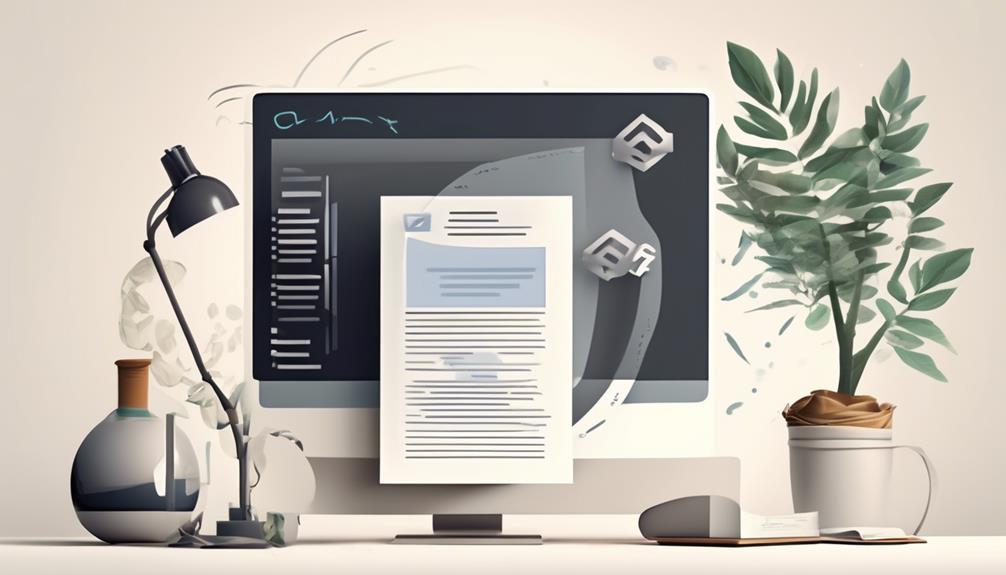We understand that reaching out to a therapist may feel daunting and uncertain, but having a well-crafted email template can make the process much easier.
As we navigate through the complexities of seeking therapy, it's essential to have a structured approach to our initial communication with a potential therapist.
We've discovered that utilizing a well-structured email template not only ensures that we convey our needs effectively but also sets the tone for a professional and respectful relationship with the therapist.
It's remarkable how a simple email can kick-start a journey towards better mental health and well-being.
Key Takeaways
- Use a professional salutation that acknowledges the therapist's expertise and the therapeutic relationship.
- Clearly articulate the purpose of reaching out and express the intention to commence therapy.
- Clearly state your intentions and purpose for reaching out to the therapist.
- Ensure the therapist has availability by asking if they are currently accepting new clients.
Crafting the Perfect Salutation
We consistently aim to craft the perfect salutation when addressing our therapist, ensuring it reflects the respect and professionalism they deserve. When sending an initial email to a therapist, the salutation sets the tone for the entire message. It's crucial to use a professional salutation that acknowledges the therapist's expertise and the therapeutic relationship.
Addressing the therapist by their title, such as 'Dear Dr. [Last Name]' or 'Hello [Therapist's Name],' demonstrates courtesy and respect. However, if you have established a more casual rapport, using their first name may be appropriate. As we embark on the journey of finding a therapist and starting therapy, it's essential to avoid overly informal salutations in the first contact unless explicitly invited to do so.
Before hitting send, it's imperative to meticulously proofread the salutation for errors and appropriateness. Taking the time to craft a thoughtful and respectful salutation in our initial email not only sets a professional tone but also lays the foundation for a positive and productive therapeutic relationship.
Structuring Your Email Introduction

To initiate our email introduction, it's important to clearly articulate the purpose of reaching out and express our intention to commence therapy. As first-time seekers of therapy, we understand the importance of starting with a strong foundation.
My name is [Preferred Name], and I use [Preferred Pronouns]. I'm reaching out to seek therapy as I'm facing challenges with [Briefly Explain Issues or Challenges]. My goals for therapy include [Briefly Explain Therapy Goals].
I'd greatly appreciate it if we could schedule a phone or video call consultation within the next [Specific Time Frame]. Additionally, I'm inquiring about your fees, payment options, and any necessary background information to help me prepare for the process.
As someone seeking therapy, I'm particularly interested in [Type of Therapy] and how it may align with my needs. Your guidance and expertise in this area are crucial to me.
Thank you for considering my inquiry, and I look forward to the possibility of working together.
Direct Communication and Clear Requests
Considering the importance of clarity in communication, it's essential to express your needs and expectations clearly when reaching out to a therapist. When addressing a therapist for the first time, it's crucial to use direct communication and make clear requests. This sets the foundation for effective therapy and ensures that your requirements are understood from the outset.
Here are some key points to keep in mind:
- Clearly state your intentions and purpose for reaching out to the therapist.
- Use direct language and be concise in your communication to avoid ambiguity.
- Clearly articulate your needs and what you're seeking from therapy.
- When requesting information, be specific and clear about what you're asking for.
- Use assertive language when making requests to ensure clarity and understanding.
Inquiring About Availability and Rates

Upon reviewing our services, you may want to inquire about therapist availability and rates to ensure that our offerings align with your needs and expectations. When reaching out to a therapist for the first time, it's a good idea to make sure they are accepting new clients and to inquire about their availability. Additionally, understanding the therapist's rates is important, and many therapists offer a sliding scale or have a set price per session. To help you navigate this process, we have created a table outlining the key questions to ask when inquiring about availability and rates:
| Questions to Ask | Description | Example |
|---|---|---|
| Are you currently accepting new clients? | Ensure the therapist has availability | "I found a therapist and am inquiring about availability" |
| What are your rates? | Inquire about the therapist's pricing structure | "Could you provide me with your price per session?" |
| Do you offer a sliding scale? | Check if the therapist offers flexible pricing | "Do you offer a sliding scale for your services?" |
As you craft your first email to a therapist, we hope this table will assist you in inquiring about availability and rates in a clear and professional manner.
Navigating Consultations and Referrals
After inquiring about therapist availability and rates, it's essential to clearly state the purpose of your outreach and inquire about the therapist's specialization when navigating consultations and referrals.
When reaching out for the first time, it's important to communicate the specific reason for seeking therapy and to ask the therapist about their areas of expertise. Additionally, it's crucial to inquire about the possibility of a consultation to discuss your mental health needs and the potential fit for therapy.
If the therapist's schedule is fully booked, it's appropriate to politely ask for referrals to other skilled colleagues who may have availability and be a good match for your needs.
Prior to contacting the therapist, it's beneficial to conduct research on their background, qualifications, and areas of specialization. Utilizing email templates for private practice can streamline communication and ensure a professional initial correspondence, making it easier to convey your needs and ask the therapist the right questions.
Frequently Asked Questions
What Should I Write in an Email to a Therapist?
We should introduce ourselves clearly and concisely, stating the reason for reaching out.
Inquire about the therapist's specialization and availability, and request information on a consultation opportunity.
It's important to address the therapist respectfully and professionally, using the appropriate salutation and proofreading for errors and appropriateness.
Researching the therapist's background, qualifications, and areas of specialization before reaching out is crucial.
If necessary, consider asking for referrals if the therapist is too busy or fully booked.
How Do I Write a Message to My Therapist?
We write a message to our therapist by addressing them respectfully, introducing ourselves, and clearly stating the purpose of our message.
We inquire about their specialization and availability and express interest in a consultation.
Keeping the email concise and to the point is important.
It's crucial to maintain a professional yet empathetic tone and to use language appropriate for a professional setting.
Can You Email Your Therapist?
Yes, you can email your therapist. It's a common practice for communication between sessions or for scheduling appointments.
However, it's essential to consider the guidelines and policies your therapist has regarding email communication. Some therapists may have specific procedures in place to ensure the confidentiality and professionalism of the communication.
Always check with your therapist about their preferred method of contact and any guidelines they have for email communication.
How Do I Break up With My Therapist Email Template?
We've decided to end our therapeutic relationship and are seeking guidance on crafting an email to communicate this.
We want to express gratitude for the support provided and clearly convey our decision to end the therapy.
We're considering including a brief explanation for our decision and are open to discussing administrative steps for closure.
We're also willing to have a final session to discuss the breakup.
Any advice on how to approach this would be appreciated.
Can I Use the Same Email Template for My Therapist as I Would for Customer Retention?
Yes, you can use the same winning customer retention email template crafting for your therapist as you would for customer retention. The key is to personalize the content to fit the specific recipient, whether it’s a client or a therapist. Tailoring the template will ensure that your message resonates effectively.
Conclusion
In the journey of mental health, reaching out for support is like finding a light in the darkness. With the right words and respectful approach, your email to a therapist can open the door to healing and growth.
Remember, your email is the first step towards a brighter tomorrow, so craft it with care and courage. The path to wellness begins with your first brave message.










